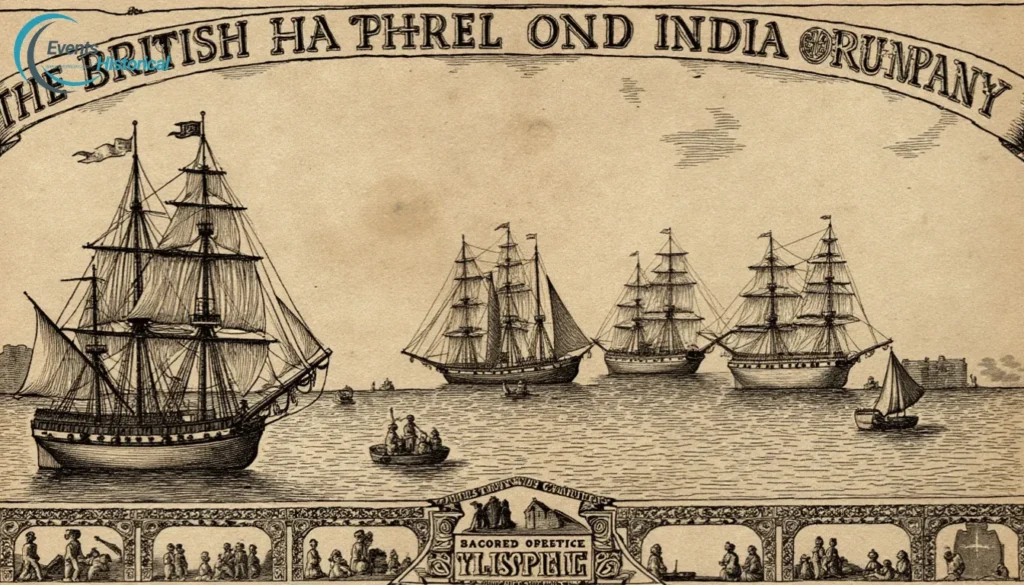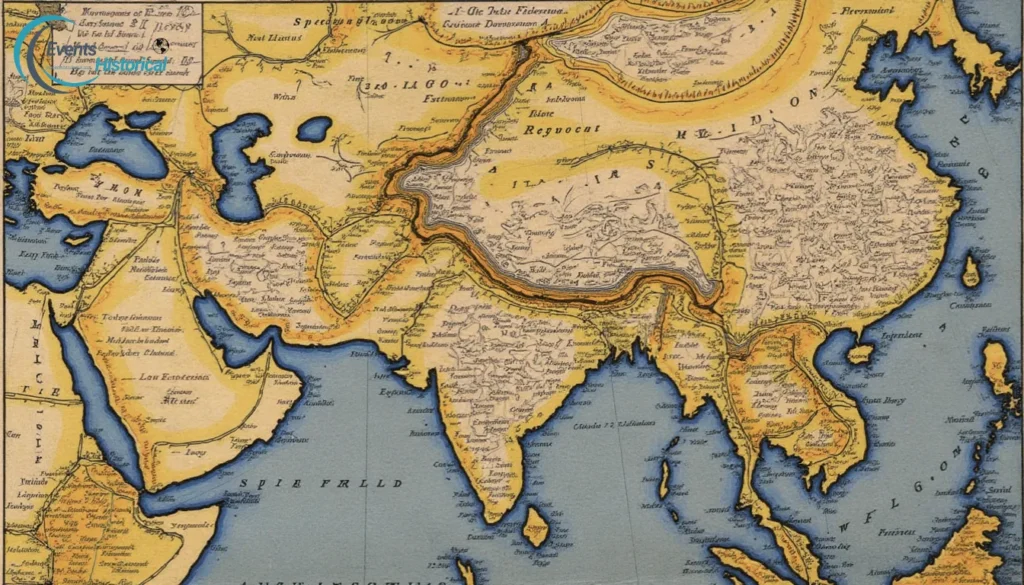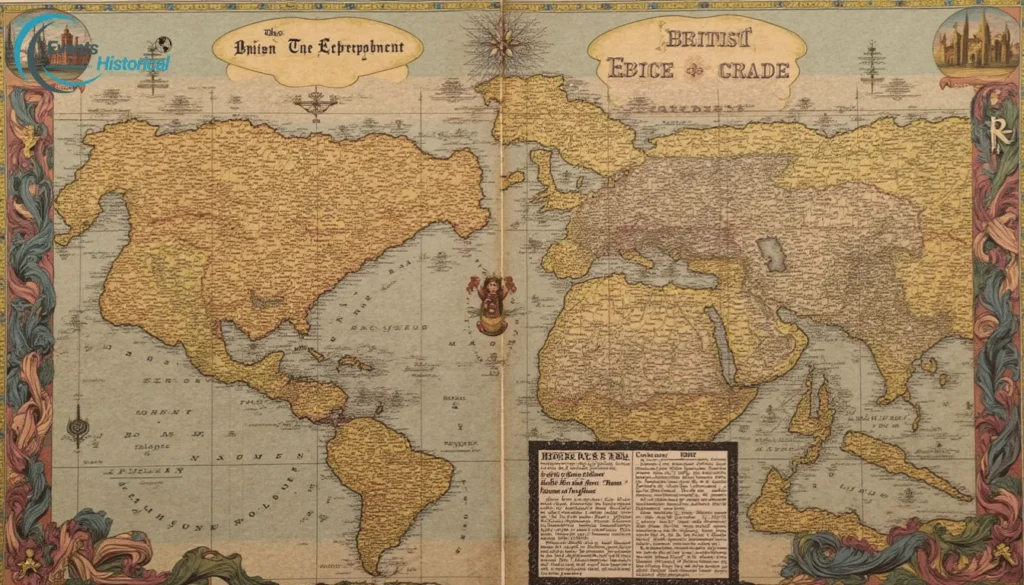Discover the history of the British East India Company (1600), a powerful force in British colonialism and trade in India. Learn about its role in shaping British influence and commerce in South Asia.
Introduction to the East India Company
East India Company history shows a broader and more than mere trading organization in history. The British East India Company was the controller of British colonialism, and business in the 17th and 18th century. Established in 1600 for commercial purposes the company soon became a very large corporation that dominated large areas of the Indian sub continent and had considerable political clout.

British East India Company: Catalyst of British Imperialism
At its height, the East India Company was instrumental in establishing British imperialism, marking the dawn of a new era in colonial history. Its influence extended far beyond commerce, intruding into the political, military, and social fabrics of the regions it touched. From the bustling ports of the East Indies to the vibrant markets of South India, the Company was a symbol of British ambition and dominance.
Known as the largest trading company, the British East India Company has a very complex story to tell. Its emergence, workings, effect on the society and its community and reasons for its decline will be researched on in this paper. This narrative research reveals how the Company influenced British imperialism, and the world economy, to better understand its multifaceted impact.

“The East India Company was the most powerful corporation in the world, a state within a state, a commercial enterprise with the power to wage war and govern vast territories.” – William Dalrymple, Historian
The British East India Company: A Pioneering Force in History
By examining its chartered beginnings under Queen Elizabeth I to its dominance in the spice and tea trades, and the role it played in pivotal historical events such as the Battle of Plassey, we will shed light on how this imperious company was both a pioneer and a cautionary tale in the annals of history. Join us as we embark on an exploration of one of the most influential defunct companies in world history.
Origins of the East India Company
The British East India Company was established on 31 December 1600 and this establishment was during the Age of discovery and merchants’ commercial spirit. Elizabeth I looked not on their fears, and in 1600 needed the Company a charter to the issue of trade in the highly profitable East Indies. This action intended to assist England deal with other European powers of the Dutch and the Portuguese who had monopoly of the spice trade in Asia.

Founders of the British East India Company: Smythe and Watts
The Company was born out of the aspirations of a group of visionary English merchants, driven by the potential for immense wealth and influence. Key figures in its inception included Sir Thomas Smythe, an influential merchant and the first governor of the Company, and Sir John Watts, a prominent shipowner and trader. Their vision was not just to expand England’s commercial reach but to establish a foothold in the global trade networks.
Let’s take a closer look at some of the significant early events that shaped the Company’s direction:
- 1600: The East India Company is officially formed under the royal charter, marking the beginning of its ambitious journey.
- 1601: The first fleet of Company ships, led by Captain James Lancaster, sets sail for the East Indies, marking the beginning of its overseas trade operations.
- 1608: The Company establishes its first trading post in Surat, India, a vital step in securing a foothold in the Indian subcontinent.
- 1613: The Company obtains permission from the Mughal Emperor Jahangir to trade and establish factories in India, solidifying its presence in the region.
- 1615: Sir Thomas Roe is sent as an ambassador to the Mughal court, further strengthening diplomatic and trade ties.
The early years of the East India Company were marked by bold ventures and strategic diplomacy, setting the stage for its transformation into a formidable force in global trade and a key player in the expansion of the British Empire. As the Company navigated the complex waters of international trade, it laid the foundations for what would become a significant chapter in world economic history.
Establishment by the British Government
1600: Chartering the British East India Company for Global Trade
The establishment of the British East India Company was a landmark event that set the stage for England’s expansion into global commerce. On December 31, 1600, Queen Elizabeth I granted a royal charter to “The Governor and Company of Merchants of London trading into the East Indies.” This charter was a pivotal document, bestowing the company with an exclusive monopoly over English trade in the East Indies for 15 years. This move was a strategic effort to empower England to compete with other European nations in the lucrative spice trade of Asia.

The British East India Company’s Charter: Autonomy and Governance
The charter granted to the Company was comprehensive, allowing it to govern itself, wage war, and negotiate treaties with foreign rulers. It provided the framework for the Company’s operations, granting it the authority to establish trading posts, fortifications, and even maintain its own military forces. This level of autonomy was unique and underscored the British government’s trust in the Company’s ability to manage and expand English trade interests.
The relationship between the East India Company and the British government was one of mutual benefit and complex interactions. The Company operated as a semi-autonomous entity, yet it was subject to regulatory oversight by the Crown. This oversight ensured that the Company aligned with national interests, particularly in terms of foreign policy and economic contributions to the state treasury. The Crown, in return, benefited from the wealth generated by the Company’s trade activities, which significantly bolstered England’s economic standing.

Powers of the British East India Company vs. Contemporary Trading Companies
To fully appreciate the unique powers of the East India Company, it is essential to compare it with other contemporary trading companies of the time:
| Company | Powers Granted | Region of Influence |
|---|---|---|
| British East India Company | Exclusive trade rights, self-governance, military authority | East Indies, South Asia |
| West India Company | Trade rights, colonization permissions | The Caribbean, West Africa |
| African Company | Trade rights, limited military authority | West Africa |
| Levant Company | Trade rights, limited self-governance | Ottoman Empire |
This comparison highlights the extensive powers and responsibilities the East India Company held, distinguishing it as a powerful instrument of British colonial economics and overseas trade.
Such a unique and empowered entity was instrumental in laying the groundwork for what would eventually become the British Empire‘s expansive reach across the globe. The Company’s establishment marked the beginning of a new era in international trade and colonial influence.
Growth into a Dominant Force
The British East India Company rapidly expanded its reach and influence, establishing itself as a dominant force in the global trade network. From its humble beginnings, the Company strategically extended its trade routes and set up numerous trading posts across the East Indies and beyond. This expansion was not only a testament to the Company’s ambitious vision but also to its adaptability and resourcefulness in navigating complex geopolitical landscapes.

East India Company: Trading Posts and Key Commodities
One of the Company’s significant achievements was the establishment of trading posts or “factories” in key locations. These included Surat in 1612, followed by Madras (now Chennai) in 1639, Bombay (now Mumbai) in 1668, and Calcutta (now Kolkata) in 1690. These strategic outposts served as vital hubs for trade and commerce, facilitating the efficient movement of goods and resources between Asia and England.
The East India Company’s trade was marked by a diverse array of goods that captured the imagination and desires of the European markets. Among the most sought-after commodities were:
- Tea: By the late 18th century, tea had become a staple in British households. The Company’s monopoly on the tea trade contributed significantly to its wealth and influence.
- Spices: Spices such as pepper, cloves, and nutmeg were among the earliest commodities traded, forming the backbone of the Company’s initial ventures.
- Textiles: Exquisite fabrics from India, including silk and cotton, were highly prized in Europe, driving substantial profits.
The scale of the Company’s trade operations can be better understood through statistics that highlight its economic impact. For instance, by the late 1700s, tea imports had surged to approximately 24 million pounds annually, underscoring the immense demand and the Company’s pivotal role in meeting it.

Key Milestones in the Rise of the British East India Company
The following are key milestones in the East India Company’s growth, illustrating its rise to prominence:
- 1612: Victory at the Battle of Swally, establishing dominance over Portuguese competitors.
- 1657: Reorganization under a new charter, enhancing its administrative capabilities and competitiveness.
- 1757: The Battle of Plassey, marking the beginning of British political control in Bengal.
- 1833: The end of the Company’s trading functions, as it transitioned to administrative roles.
These milestones reflect the Company’s transformative journey from a trading entity to a central pillar of the burgeoning British Empire. The World History Encyclopedia provides further insights into the strategic maneuvers that propelled the Company to its dominant position.
Through its relentless pursuit of new markets and commodities, the British East India Company set the stage for modern international trade, leaving an indelible mark on British colonial history and the global economy.
Military and Political Involvement
The British East India Company was not merely a trading entity; it evolved into a formidable military and political force, playing a crucial role in the territorial expansion of the British Empire in South Asia. Its involvement in military conflicts and political affairs significantly shaped the region’s history, leaving lasting impacts on the dynamics of power and governance.

Military and Political Strategies of the British East India Company
In its pursuit of economic dominance, the Company engaged in numerous military endeavors to protect and expand its interests. Its private army, which eventually became one of the largest military forces in the world, was instrumental in its territorial ambitions. The Company’s military engagements included:
- The Carnatic Wars (1746-1763): These conflicts with the French East India Company established British supremacy in Southern India.
- The Anglo-Mysore Wars (1767-1799): A series of battles against the Kingdom of Mysore, leading to significant territorial gains.
- The Anglo-Maratha Wars (1775-1818): These wars resulted in the subjugation of the Maratha Empire and further expansion of British territories.
The Company’s political influence in the region was equally profound. It forged strategic alliances and exerted substantial control over local rulers, often manipulating regional politics to its advantage. The Company’s governance strategy included:
- Subsidiary Alliances: Agreements that placed Indian rulers under British protection in exchange for military support, effectively reducing their sovereignty.
- Diwani Rights: Granted in 1765, this allowed the Company to collect revenues and administer justice in Bengal, marking the start of its administrative control.
- Resident Systems: British Residents were appointed in Indian courts to oversee and influence local governance.
The Battle of Plassey: A Turning Point for the British East India Company
One of the most pivotal events illustrating the Company’s military and political prowess was the Battle of Plassey in 1757. This conflict marked a turning point in the Company’s fortunes, where its forces, led by Robert Clive, defeated the Nawab of Bengal, Siraj ud-Daulah. The victory at Plassey was achieved through a combination of military strategy and clandestine political maneuvering, including the betrayal of key allies of the Nawab. This triumph not only established the Company’s military dominance but also paved the way for its political control over Bengal, setting the stage for British rule in India.
| Conflict | Outcome | Significance |
|---|---|---|
| Battle of Plassey (1757) | Victory for the East India Company | Beginning of Company rule in Bengal |
| Carnatic Wars | British supremacy in Southern India | Elimination of French competition |
| Anglo-Mysore Wars | Territorial expansion | Control over Mysore |
The East India Company’s military and political activities were pivotal in the transformation of the British Empire’s presence in South Asia. For further reading on the Company’s military strategies and political tactics, you can explore the GlobalSecurity resource on the British East India Company. These endeavors not only altered the course of Indian history but also laid the groundwork for modern colonial governance and its complex legacy.
Impact on Indian Society and Economy
The British East India Company profoundly reshaped the economic and social fabric of India. As the Company expanded its trade operations, it introduced significant changes that had lasting effects on the country’s economy and society. This transformation was marked by both growth and disruption, influencing local industries, customs, and cultural exchanges.

Economic Changes
The Company’s trade practices brought about dramatic shifts in the Indian economy. The focus on export-oriented production led to the prioritization of cash crops such as opium, indigo, and cotton, often at the expense of traditional agriculture. This shift had profound implications for local farmers and the rural economy:
- Monoculture and Dependency: Farmers increasingly relied on single cash crops, which made them vulnerable to market fluctuations and dependent on the Company’s trading networks.
- Decline of Local Industries: The influx of British manufactured goods, such as textiles, led to the decline of local crafts and industries, particularly the famed Indian textile industry.
- Revenue Collection: The Company’s system of land revenue collection, known as the Zamindari system, altered traditional land ownership patterns and often resulted in increased peasant indebtedness.
In a striking anecdote, a weaver from Bengal lamented, “The Company’s demands have left us with no choice but to abandon our looms, as we cannot compete with the flood of British textiles.” This insight captures the economic upheaval faced by local artisans.
Cultural Exchanges and Influences
The interaction between the British and Indian societies led to a complex blend of cultural exchanges. The Company’s presence in India facilitated the introduction of Western education, legal systems, and administrative practices, which had both positive and negative outcomes:
- Introduction of English Education: The establishment of schools and colleges offering English education helped create a new class of educated Indians, contributing to the Bengal Renaissance and later, the Indian independence movement.
- Legal and Administrative Reforms: The introduction of British legal frameworks and governance structures altered traditional Indian judicial systems and administrative practices.
- Cultural Synthesis: The blending of cultures led to new forms of art, music, and architecture, reflecting a fusion of Indian and British influences.

An interesting historical account tells of Raja Rammohan Roy, a reformer who embraced Western education and advocated for social change, demonstrating how cultural exchanges sparked intellectual and social transformation in India.
| Aspect | Impact | Examples |
|---|---|---|
| Economic | Shift to cash crops, decline of local industries | Opium trade, textile industry decline |
| Cultural | Western education, legal reforms | Bengal Renaissance, new legal codes |
The East India Company’s impact on Indian society and economy was multifaceted, with far-reaching consequences that continue to influence modern India. While it brought about economic growth and cultural exchange, it also led to social disruptions and economic dependencies. Understanding these historical dynamics is crucial for appreciating the complex legacy of the Company’s rule in India.
Decline and Dissolution of the East India Company
The decline of the British East India Company was as dramatic as its rise. A combination of political pressures and economic challenges culminated in the eventual dissolution of one of the most powerful trading companies in history. This section delves into the myriad factors that contributed to its downfall, with a focus on the pivotal Indian Rebellion of 1857 and the subsequent transition to direct British rule.

Factors Leading to Decline
The East India Company’s decline was influenced by several interconnected factors:
- Economic Challenges: The Company faced mounting debts due to costly military campaigns and administrative expenses, which strained its financial resources.
- Political Pressures: Growing dissatisfaction among British politicians with the Company’s governance and the impact of its policies on India led to increased scrutiny and demands for reform.
- Regulatory Changes: The Government of India Act 1833 curtailed the Company’s commercial activities, restricting its role to administration, thereby eroding its economic power.
These challenges were compounded by administrative inefficiencies and corruption within the Company, further weakening its position.
The Indian Rebellion of 1857
The Indian Rebellion of 1857 marked a turning point in the Company’s history. Triggered by widespread discontent with British rule and specific grievances against the Company’s practices, the rebellion exposed the Company’s inability to maintain control over its territories. The aftermath of the rebellion had significant repercussions:
- Dissolution of the Company: The rebellion led to a loss of trust in the Company’s ability to govern, prompting the British Crown to assume direct control over India.
- Transition to British Rule: The enactment of the Government of India Act 1858 transferred administrative powers from the Company to the British government, effectively ending the Company’s rule.
In the words of a contemporary British official, “The Indian mutiny has shattered the illusion of Company’s infallibility, necessitating a new era of governance under the Crown.“

Data on the Final Years
The final years of the East India Company were characterized by a rapid transition in governance:
| Year | Event | Significance |
|---|---|---|
| 1857 | Indian Rebellion | Widespread uprising against Company rule |
| 1858 | Government of India Act | Transfer of power to British Crown |
| 1874 | Dissolution | Formal dissolution of the Company |
By 1874, the East India Company was formally dissolved, marking the end of an era characterized by both unprecedented trade expansion and profound socio-political impact.
The dissolution of the East India Company underscores the complexities of empire-building and the cyclical nature of power. As its influence waned, the baton of empire was passed to the British Crown, heralding a new chapter in the history of British colonialism in India.
Lasting Effects on British Colonialism and Global Trade
The legacy of the British East India Company is etched deeply into the annals of history, with far-reaching consequences on both British colonialism and global trade patterns. As we explore its enduring impact, it becomes clear that the Company’s operations set the stage for a global economic transformation and influenced colonial policies that shaped the modern world.

Impact on Global Trade Patterns
The East India Company was a pioneer in establishing trade networks that linked diverse regions across the globe. Its influence on global trade can be seen in various aspects:
- Expansion of Trade Routes: The Company played a crucial role in connecting Europe with Asia, facilitating the exchange of goods, cultures, and ideas.
- Standardization of Trade Practices: The Company’s operations introduced standardized practices in international trade, laying the groundwork for future trade agreements and regulations.
- Introduction of New Commodities: Products such as tea, spices, and textiles became staples in European markets, influencing consumer habits and economic structures.
The ripple effects of these developments can still be observed in today’s interconnected global economy.
Influence on British Colonial Policies
The influence of the East India Company extended beyond trade, significantly shaping British colonial policies:
- Administrative Framework: The Company’s governance strategies in India served as a model for British administration in other colonies, emphasizing centralized control and economic exploitation.
- Military Strategy: The Company’s military engagements and alliances informed British imperial defense policies, highlighting the importance of local alliances and strategic territorial control.
- Cultural Impact: The Company facilitated cultural exchanges, although often skewed by colonial perspectives, which impacted British societal views on Asia and its people.
The Company’s legacy is a complex tapestry of economic and political strategies that influenced subsequent colonial endeavors.

Key Takeaways on Modern Economies
- Foundation of Modern Corporations: The business model of the East India Company laid the groundwork for the development of modern multinational corporations.
- Globalization: The Company’s trade networks were an early form of globalization, shaping the modern global economy.
- Economic Disparities: The economic practices initiated by the Company contributed to global disparities that continue to affect international relations and economic policies.
In essence, the British East India Company was more than a trading entity; it was a catalyst for profound changes that have endured into the present day. Its legacy, though marked by both progress and exploitation, offers valuable lessons for understanding the dynamics of global trade and colonial history.
Conclusion
The journey of the British East India Company from its inception in 1600 to its eventual dissolution is a narrative of ambition, power, and profound impact on world history. As we delved into this storied past, several key points emerged:
- Origins and Ambitions: Founded under the auspices of a royal charter granted by Queen Elizabeth I, the Company set out with the bold vision of establishing England as a dominant force in global trade, particularly in the lucrative markets of Asia.
- Expansion and Influence: Through strategic alliances and military prowess, the East India Company expanded its reach, establishing trading posts throughout the East Indies and wielding considerable political influence in India.
- Economic and Cultural Impact: The Company’s operations introduced new goods and economic practices that reshaped both local societies and global markets, leaving a lasting imprint on British colonialism and modern economies.
- Decline and Legacy: Despite its eventual decline due to political pressures and economic challenges, the legacy of the East India Company endures in the structures of modern international trade and the complexities of colonial history.
Reflecting on this period, we are reminded of the dual-edged nature of colonial expansion — it brought about significant advancements in trade and economic structures, yet it also led to exploitation and cultural upheavals. The history of the East India Company invites us to ponder the ethical dimensions of economic pursuits and the long-term consequences of imperial ambitions.
In the words of historian William Dalrymple, “The story of the British East India Company serves as a cautionary tale about the dangers of unchecked corporate power.” As you consider the legacy of this formidable institution, ask yourself: How can we learn from the past to shape a more equitable and just future in global trade and governance?
FAQ Section
FAQs on British East India Company History and Legacy
Delve deeper into the intriguing history of the British East India Company with this FAQ section. Here, we address some of the most commonly asked questions about the Company’s operations, influence, and lasting legacy.
What was the primary purpose of the British East India Company?
The British East India Company was established primarily to conduct and control overseas trade with the East Indies, focusing on lucrative commodities such as spices, textiles, and tea. The Company played a pivotal role in expanding British influence in Asia and beyond.
How did the East India Company impact Indian society and economy?
The Company’s influence was profound, leading to significant changes in economic structures, social hierarchies, and cultural practices. It facilitated the introduction of British colonial economics and governance, which had lasting effects on India’s development. For a more detailed analysis, see the Indianetzone – British East India Company.
What led to the decline of the East India Company?
The decline of the Company was precipitated by a combination of political pressures, economic challenges, and the Indian Rebellion of 1857. These factors eroded its control, eventually leading to the dissolution of the Company and the establishment of direct British rule in India.
How did the East India Company influence global trade?
The Company was a trailblazer in international trade, establishing trade routes that connected Europe, Asia, and beyond. Its operations set the stage for modern global trade practices and corporate governance models.
Where can I learn more about the East India Company?
For further reading, explore resources like the World History Encyclopedia – East India Company and the East India Company – Student Encyclopedia. These links offer comprehensive insights into the Company’s storied past and its enduring legacy.
The British East India Company’s Role in Modern India
We hope this FAQ section has answered your curiosities about the British East India Company’s influential role in shaping modern India and the broader historical landscape. Feel free to explore the provided links to deepen your understanding further!

